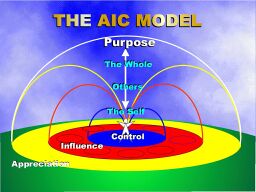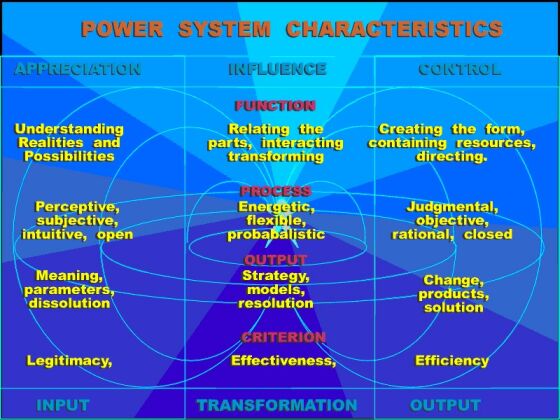The information revolution is bringing fundamental changes in the way we relate to each other in both our work and private lives. The call for democracy and participation world-wide is changing the way nations relate to each other and the way we relate to our own institutions and nations.
Science, symbolized by the penetrating vision of the Hubble
telescope, is extending and changing the way we perceive the Universe as
a whole. The front pages of our major newspapers and magazines declare a
new level of interest in Spirituality while scientists show how our brains
are wired for the spiritual experience. Everywhere, we are being compelled
to re-examine who we are, how we are the same and different from others,
how we learn, how we relate to others, and how live and work together.
The current models of organization that are embedded in our social
institutions such as government, education and business are not adaptive
or responsive enough to meet these challenges. Our turbulent times call
for more dynamic models which operate at a higher order of organization.
We need models that can cope with and honor infinite levels of difference
in human, social, political and technical capacities. We need models that
can transcend such difference to provide meaning and direction that can
serve as a basis for integrating difference without suppressing it.
ODII has been developing such an approach. Called AIC - Appreciation, Influence and Control, it was created under the leadership of William E. Smith as part of an action research project while consulting with the World Bank between 1978 - 1985,. (" Design of Organizations for Rural Development", 1980).
Though the experience on which the process is based was drawn, initially, from work in the private sector (see article on Evolution of Multinational Corporations) the concepts were formalized while working on broader problems of development in the context of the World Bank, and Regional Development Banks and the Inter-American Development Bank] and United Nations development programs.

Chart 1 - AIC is copyrighted by "AIC Natural Systems Inc."
AIC is an organizing process that draws equally from the wisdom of ancient
cultural traditions and from modern sciences. It is built on an understanding
of the relationship between purpose and power. Every purpose creates a power
field. The AIC process seeks to ensure that the full potential of that purpose
is realized through the management of the three major components of the
power field.
A - Appreciation - the power we use in relating to the "whole" system.
I - Influence - the power we use in relating to other "parts" of the system.
C - Control - the power we use with ourselves as an "individual part" of the whole system.
It sees the challenge of achieving the full potential of purpose
as that of organizing the right mix of appreciative, influence and
control relationships. The AIC process applies equally at the
individual, organizational and community levels.
While intellectually the process draws heavily on the major social science
developments of the last fifty years - Kurt Lewin's field theory, Eric Trist's
socio-technical system's and Russell Ackoff's interactive planning- and
is consistent with the New Sciences - Relativity, Quantum physics and Chaos
theory - it has also learnt from traditional approaches to organizing in
all major cultures and all major religions. The result is a simple, elegant
model that applies equally to the design of a fifteen minute meeting or
a fifteen year national development program in any culture. See the Story of AIC in the article
"Wholeness...." in the Papers Section)
The Main Characteristics of AIC
AIC is a philosophy based on an understanding that power relationships are central to the process of organizing. This philosophy states, that purpose, not wealth, authority or knowledge, is the source of power. Every purpose no matter how big or small creates a power field that has the same AIC properties.
AIC is a model that illustrates the relationship between purpose and power. The model is named after the three fundamental and universal relationships involved in the design of any purposeful system-- the relationship to the whole (appreciation), the relationship between the parts of the whole system ( influence), and the relationship of the individual part to itself (control). Just as the mixing of three primary colors can give millions of different colors, so can the mixing of A, I and C give millions of shadings of power relationships.

Chart 2
Appreciation
The function of appreciation is to connect us to that part of the whole power field that is outside our area of control or influence. We achieve this appreciation by opening ourselves up, by letting go of our attempts to influence and control. When we do we can fully utilize our intuitive and sensing capacities to perceive the full depth of realities and the full scope of possibilities that are latent in the power field created by our purpose. Successful appreciation helps us identify our ideal purposes, it gives ultimate meaning to our activities, it provides the outer parameters or boundaries of trust and dissolves many issues of influence and control before they can even arise. Successful appreciation is assessed by such criterion as the legitimacy of the purposes being served. Are the legitimate purpose of the self, the others and the whole being met?
Influence
The function of influence is to put all the parts of the whole in relationship to each other to build the best model of the past, present and future of the situation and the best strategies for achieving the purpose. Influence transforms the output of appreciation into relationship of value to each of the parts of the whole (stakeholders). Influence operates though a dynamic process of interchange that makes the best and worst possible outcomes evident to each part. Whereas appreciation stays open to all possibilities influence is concerned with identifying the few variables, the few strategies that have the highest probability of achieving the purpose. Successful influence still remains open to new appreciations but produces a satisfactory resolution of all the conflicting interests of the stakeholders. The ultimate criterion of successful influence is the effectiveness of the judgments made about the role and relationships between the stakeholders and the elements of the strategy or model of the whole employed.
Control
The function of control is to determine the form in which the purpose will be made manifest in the world. Whereas appreciation provides IN-formation, influence provides TRANS-formation and control provides FORM-ation. Whereas appreciation is open to all possibilities, influence seeks the best probabilities, control must close options down to the one actuality that will be realized in a specific time-frame, with specific production parameters. Control takes the infinite subjective possibilities of appreciation and reduces them to the single objective, produced reality. Control provides the actual form of a solution. Whereas the role the appreciative field is to create conditions that avoids or dissolves problems of influence and control, and the influence field reaches a satisfactory resolution between mutually incompatible interests, control is the only level that solves problems. We can only solve a problem when we have control of all the variables affecting its solution.. The solution changes reality forever and creates the need for a re-appreciation of current realties. So the process begins again.
AIC is an organizing process which consists of:
a) identifying the purpose to be served;
b) framing the power-field around that purpose -- those
who have control, influence and appreciation relative to the purpose;
c) selecting those with the most influence relative to the
purpose (stakeholders) from the three circles and designing a process
of interaction between them; and
d) facilitating a self-organizing process which ensures
that the stakeholders:
1) step back from the current problems to fully appreciate
the realities and possibilities inherent in the whole situation;
2) examine the logical and strategic options as well as the subjective
feelings and values involved in selecting strategies; and
3) allow for free and informed choice of action by those responsible
for implementing decisions.
AIC is not wedded to any particular methodology. It provides a framework that helps organizers choose or design methodologies appropriate to the phase of the organizing cycle and to the local situation. For example, the appreciative phase can use brainstorming, search conferences, Delphi techniques, story-telling, art, etc. In the influence phase, it can use methodologies such as dialogue, open-space, negotiation and conflict resolution. In the control phase it can use such methodologies as Management by Objectives, the Logical Framework, ZOPP, and PERT.
The AIC self-organizing process is consciously trans-cultural. Through the study of natural and formal organizations in many cultures we have learnt that individuals, organizations and cultures manifest a particular pattern of appreciation, influence and control. The AIC process uses this knowledge to draw out the best of each culture's natural process but also to transcend its natural limitations.
Applications
The AIC self-organizing process has been applied worldwide
to both public and private organizations. It has been used at every level-
village, regional, national and global. It has been applied to projects
ranging from village development to the design of national policy in Cambodia,
Colombia, Hungary, Indonesia, Mali, Norway, Sierra Leone, Thailand and the
United States.
It has addressed very technical issues such as the design of policies for
energy, very political issues such as the peace process in Cambodia, and
complex institutional issues such as the design of market systems for Hungary.
In Thailand, the self-organizing process has taken on a life of its own,
in both the private and public sectors. A Thai Foundation, which promotes
the process, has been formed under royal patronage. A series of "five star"
partnerships between the government, the private sector, community and religious
organizations and NGOs has been created to promote programs of development
that extend to 50,000 villages. In 1996 The National Planning NESDB completed
the first national plan using the AIC process. (Paper D. James MacNeil)